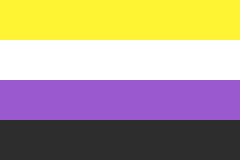นอนไบนารี
 | |
| ประเภท | อัตลักษณ์ทางสถานะเพศ |
|---|---|
| ย่อ |
|
| คำอื่น ๆ | |
| คำพ้องความหมาย | เจนเดอร์เควียร์ |
| คำที่เกี่ยวข้อง | |
นอนไบนารี (อังกฤษ: non-binary)[a] และ เจนเดอร์เควียร์ (อังกฤษ: genderqueer) เป็นคำที่ให้ความหมายกว้าง (umbrella term) ของอัตลักษณ์ทางสถานะเพศที่ไม่ใช่เพียงเพศชายและเพศหญิงเท่านั้น (อัตลักษณ์ที่อยู่นอกเหนือเพศทวิลักษณ์)[2][3] อัตลักษณ์นอนไบนารีมักถูกรวมว่าอยู่ใต้ร่มของคนข้ามเพศ (transgender) เนื่องจากบุคคลที่เป็นนอนไบนารีโดยทั่วไปจะระบุตัวตนด้วยสถานะเพศที่แตกต่างจากเพศที่กำหนดไว้โดยกำเนิด[3] แม้ว่านอนไบนารีบางคนจะไม่ถือว่าตัวเองเป็นคนข้ามเพศก็ตาม[4][5]
บุคคลที่เป็นนอนไบนารีอาจระบุตัวตนว่าเป็นเพศกลางหรือเพศที่สามที่แยกออกไปต่างหาก[6] ซึ่งระบุได้มากกว่าหนึ่งสถานะเพศ[7][8] หรือไม่มีสถานะเพศ หรือมีอัตลักษณ์ทางสถานะเพศลื่นไหลไปมา[9] อัตลักษณะทางสถานะเพศเป็นเรื่องแยกต่างหากจากรสนิยมทางเพศและรสนิยมทางโรแมนติก[10] บุคคลที่เป็นนอนไบนารีมีรสนิยมทางเพศได้หลากหลาย[11]
การเป็นนอนไบนานีไม่เหมือนกับภาวะเพศกำกวม บุคคลผู้มีภาวะเพศกำกวมส่วนใหญระบุตนว่าเป็นผู้ชายหรือผู้หญิงอย่างใดอย่างหนึ่ง[12] แม้ว่าบางคนจะระบุตนว่าเป็นเพียงนอนไบนารี บางคนระบุตนว่าเป็นนอนไบนารีและสถานะเพศเลื่อนไหล เช่น ฮิดา วิโลเรีย (Hida Viloria) ในขณะที่คนอื่น ๆ ระบุตนว่าเป็นผู้ชายที่เป็นนอนไบนารี หรือผู้หญิงที่เป็นนอนไบนารี
บุคคลที่เป็นนอนไบนารีเป็นกลุ่มบุคคลที่มีการแสดงออกถึงสถานะเพศที่แตกต่างกันออกไป และบางคนอาจปฏิเสธสถานะเพศทั้งหมด[13] บุคคลที่เป็นนอนไบนารีบางคนได้รับการบริบาลด้านการยืนยันสถานะเพศเพื่อลดความลำบากใจที่เกิดจากความทุกข์ใจในเพศสภาพ เช่น การผ่าตัดยืนยันสถานะเพศหรือการบำบัดด้วยฮอร์โมนทดแทน[14]
ดูเพิ่ม
[แก้]หมายเหตุ
[แก้]อ้างอิง
[แก้]- ↑ Bergman, S. Bear; Barker, Meg-John (2017). "Non-binary Activism". ใน Richards, Christina; Bouman, Walter Pierre; Barker, Meg-John (บ.ก.). Genderqueer and Non-Binary Genders. Critical and Applied Approaches in Sexuality, Gender and Identity. Palgrave Macmillan. p. 43. ISBN 978-1-137-51052-5.
- ↑ Richards, Christina; Bouman, Walter Pierre; Seal, Leighton; Barker, Meg John; Nieder, Timo O.; T'Sjoen, Guy (2016). "Non-binary or genderqueer genders". International Review of Psychiatry. 28 (1): 95–102. doi:10.3109/09540261.2015.1106446. hdl:1854/LU-7279758. PMID 26753630. S2CID 29985722. เก็บจากแหล่งเดิมเมื่อ June 26, 2019. สืบค้นเมื่อ June 9, 2019.
- ↑ 3.0 3.1 "Supporting & Caring for Transgender Children" (PDF). Human Rights Campaign. คลังข้อมูลเก่าเก็บจากแหล่งเดิม (PDF)เมื่อ July 24, 2021. สืบค้นเมื่อ April 8, 2021.
- ↑ "Trans + Gender Identity". The Trevor Project. เก็บจากแหล่งเดิมเมื่อ July 4, 2018. สืบค้นเมื่อ October 11, 2019.
- ↑ Ennis, Dawn (July 13, 2021). "New Research Reveals Insights Into America's Nonbinary Youth". Forbes. เก็บจากแหล่งเดิมเมื่อ January 6, 2022. สืบค้นเมื่อ January 6, 2022.
- ↑ Beemyn, Brett Genny (2008). "Genderqueer". glbtq: An Encyclopedia of Gay, Lesbian, Bisexual, Transgender, and Queer Culture. Chicago, Illinois: glbtq, Inc. คลังข้อมูลเก่าเก็บจากแหล่งเดิมเมื่อ April 25, 2012. สืบค้นเมื่อ May 3, 2012.[ต้องการเลขหน้า]
- ↑ Bosson, Jennifer K.; Vandello, Joseph A.; Buckner, Camille E. (2018). The Psychology of Sex and Gender. Thousand Oaks, California: Sage Publications. p. 54. ISBN 978-1-5063-3134-8. OCLC 1038755742. เก็บจากแหล่งเดิมเมื่อ May 28, 2020. สืบค้นเมื่อ August 4, 2019 – โดยทาง Google Books.
- ↑ Whyte, Stephen; Brooks, Robert C.; Torgler, Benno (September 25, 2018). "Man, Woman, "Other": Factors Associated with Nonbinary Gender Identification". Archives of Sexual Behavior. Heidelberg, Germany: Springer Science+Business Media. 47 (8): 2397–2406. doi:10.1007/s10508-018-1307-3. PMID 30255409. S2CID 52823167.
2 out of 7479 (0.03 percent) of respondents to the Australian Sex Survey, a 2016 online research survey, self-identified as trigender.
- ↑ Winter, Claire Ruth (2010). Understanding Transgender Diversity: A Sensible Explanation of Sexual and Gender Identities. Scotts Valley, California: CreateSpace. ISBN 978-1-4563-1490-3. OCLC 703235508.[ต้องการเลขหน้า]
- ↑ "Transgender Glossary of Terms". GLAAD Media Reference Guide. Gay & Lesbian Alliance Against Defamation. เก็บจากแหล่งเดิมเมื่อ May 30, 2012. สืบค้นเมื่อ May 25, 2011.
- ↑ Stryker, Susan (2008). Transgender History. Berkeley, California: Seal Press. ISBN 978-1-58005-224-5. OCLC 183914566.[ต้องการเลขหน้า]
- ↑ "Understanding Non-Binary People: How to Be Respectful and Supportive". National Center for Transgender Equality. July 9, 2016. เก็บจากแหล่งเดิมเมื่อ April 6, 2020. สืบค้นเมื่อ June 17, 2020.
- ↑ Schorn, Johanna. "Taking the 'Sex' out of Transsexual: Representations of Trans Identities in Popular Media" (PDF). Inter-Disciplinary.Net. Cologne, Germany: University of Cologne. p. 1. คลังข้อมูลเก่าเก็บจากแหล่งเดิม (PDF)เมื่อ October 25, 2014. สืบค้นเมื่อ October 23, 2014.
The term transgender is an umbrella term 'and generally refers to any and all kinds of variation from gender norms and expectations' (Stryker 19). Most often, the term transgender is used for someone who feels that the sex assigned to them at birth does not reflect their own gender identity. They may identify as the gender "opposite" to their assigned gender, or they may feel that their gender identity is fluid, or they may reject all gender categorizations and identify as agender or genderqueer.
- ↑ Hastings, Jennifer (June 17, 2016). "Approach to genderqueer, gender non-conforming, and gender nonbinary people". UCSF Transgender Care. เก็บจากแหล่งเดิมเมื่อ October 6, 2021. สืบค้นเมื่อ October 10, 2021.
อ่านเพิ่มเติม
[แก้]- Barker, Meg-John; Scheele, Julia (2016). Queer: A Graphic History. London: Icon Books. ISBN 978-1-78578-071-4. OCLC 939427299.
- Bernstein Sycamore, Mattilda, บ.ก. (2006). Nobody Passes: Rejecting the Rules of Gender and Conformity. Emeryville: Seal Press. ISBN 978-1-58005-184-2. OCLC 50389309.
- Bornstein, Kate; Bergman, S. Bear, บ.ก. (2010). Gender Outlaws: The Next Generation (Reprint ed.). Berkeley: Seal Press. ISBN 978-1-58005-308-2. OCLC 837948378.
- Fine, Cordelia (2011). Delusions of Gender: How Our Minds, Society, and Neurosexism Create Difference (Reprint ed.). New York: W. W. Norton & Company. ISBN 978-0-393-34024-2. OCLC 449865367.
- Fineman, Martha Albertson (2013). "Feminism, masculinities, and multiple identities". Nevada Law Journal. 13 (2): 16. เก็บจากแหล่งเดิมเมื่อ December 11, 2017. สืบค้นเมื่อ December 11, 2017.
- Hines, Melissa (2005). Brain Gender. Oxford University Press. ISBN 978-0-19-518836-3. OCLC 846105995.
- Nestle, Joan; Howell, Clare; Wilchins, Riki Anne, บ.ก. (2002). GenderQueer: Voices from Beyond the Sexual Binary. Los Angeles: Alyson Books. ISBN 978-1-55583-730-3. OCLC 50389309.
- Peterson, Tim Trace; Tolbert, T. C., บ.ก. (2013). Troubling the Line: Trans and Genderqueer Poetry and Poetics. Callicoon: Nightboat Books. ISBN 978-1-937658-10-6. OCLC 839307399.
- Richards, C., Bouman, W. P., & Barker, M.-J. (2017). Genderqueer and non-binary genders. London: Palgrave Macmillan. ISBN 978-1-137-51052-5. OCLC 1021393997.
- Scout (July 23, 2013). "(A) Male, (B) Female, (C) Both, (D) Neither". The Huffington Post. AOL. เก็บจากแหล่งเดิมเมื่อ July 27, 2013. สืบค้นเมื่อ August 2, 2013.
- Stryker, Susan; Whittle, Stephen, บ.ก. (2006). The Transgender Studies Reader. New York: Routledge. ISBN 978-1-58005-184-2. OCLC 50389309.
แหล่งข้อมูลอื่น
[แก้] นิยามแบบพจนานุกรมของ en:non-binary ที่วิกิพจนานุกรม
นิยามแบบพจนานุกรมของ en:non-binary ที่วิกิพจนานุกรม วิกิคำคม มีคำคมที่กล่าวโดย หรือเกี่ยวกับ en:Non-binary gender
วิกิคำคม มีคำคมที่กล่าวโดย หรือเกี่ยวกับ en:Non-binary gender
